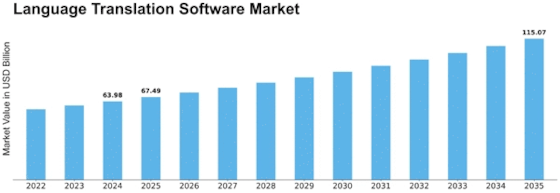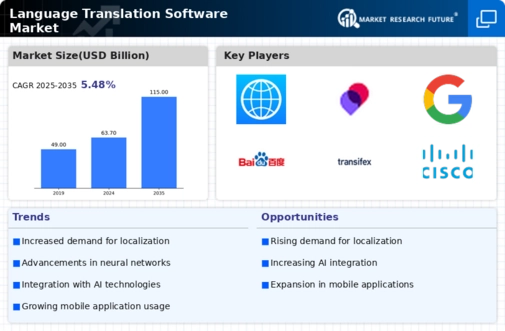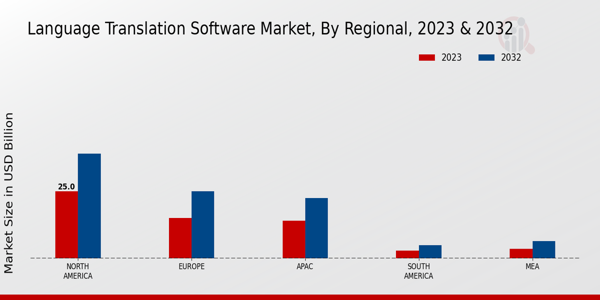Document Translation
Website Translation
Mobile App Translation
Real-Time Translation
Subtitling and Captioning
Cloud-Based
On-Premise
Hybrid
Education
Travel and Tourism
E-commerce
Healthcare
Legal
Machine Translation
Human Translation
Translation Memory
Statistical Translation
Neural Machine Translation
North America
Europe
South America
Asia Pacific
Middle East and Africa
North America Outlook (USD Billion, 2019-2032)
North America Language Translation Software Market by Application Type
Document Translation
Website Translation
Mobile App Translation
Real-Time Translation
Subtitling and Captioning
North America Language Translation Software Market by Deployment Type
Cloud-Based
On-Premise
Hybrid
North America Language Translation Software Market by End Use Type
Education
Travel and Tourism
E-commerce
Healthcare
Legal
North America Language Translation Software Market by Technology Type
Machine Translation
Human Translation
Translation Memory
Statistical Translation
Neural Machine Translation
North America Language Translation Software Market by Regional Type
US
Canada
US Outlook (USD Billion, 2019-2032)
US Language Translation Software Market by Application Type
Document Translation
Website Translation
Mobile App Translation
Real-Time Translation
Subtitling and Captioning
US Language Translation Software Market by Deployment Type
Cloud-Based
On-Premise
Hybrid
US Language Translation Software Market by End Use Type
Education
Travel and Tourism
E-commerce
Healthcare
Legal
US Language Translation Software Market by Technology Type
Machine Translation
Human Translation
Translation Memory
Statistical Translation
Neural Machine Translation
CANADA Outlook (USD Billion, 2019-2032)
CANADA Language Translation Software Market by Application Type
Document Translation
Website Translation
Mobile App Translation
Real-Time Translation
Subtitling and Captioning
CANADA Language Translation Software Market by Deployment Type
Cloud-Based
On-Premise
Hybrid
CANADA Language Translation Software Market by End Use Type
Education
Travel and Tourism
E-commerce
Healthcare
Legal
CANADA Language Translation Software Market by Technology Type
Machine Translation
Human Translation
Translation Memory
Statistical Translation
Neural Machine Translation
Europe Outlook (USD Billion, 2019-2032)
Europe Language Translation Software Market by Application Type
Document Translation
Website Translation
Mobile App Translation
Real-Time Translation
Subtitling and Captioning
Europe Language Translation Software Market by Deployment Type
Cloud-Based
On-Premise
Hybrid
Europe Language Translation Software Market by End Use Type
Education
Travel and Tourism
E-commerce
Healthcare
Legal
Europe Language Translation Software Market by Technology Type
Machine Translation
Human Translation
Translation Memory
Statistical Translation
Neural Machine Translation
Europe Language Translation Software Market by Regional Type
Germany
UK
France
Russia
Italy
Spain
Rest of Europe
GERMANY Outlook (USD Billion, 2019-2032)
GERMANY Language Translation Software Market by Application Type
Document Translation
Website Translation
Mobile App Translation
Real-Time Translation
Subtitling and Captioning
GERMANY Language Translation Software Market by Deployment Type
Cloud-Based
On-Premise
Hybrid
GERMANY Language Translation Software Market by End Use Type
Education
Travel and Tourism
E-commerce
Healthcare
Legal
GERMANY Language Translation Software Market by Technology Type
Machine Translation
Human Translation
Translation Memory
Statistical Translation
Neural Machine Translation
UK Outlook (USD Billion, 2019-2032)
UK Language Translation Software Market by Application Type
Document Translation
Website Translation
Mobile App Translation
Real-Time Translation
Subtitling and Captioning
UK Language Translation Software Market by Deployment Type
Cloud-Based
On-Premise
Hybrid
UK Language Translation Software Market by End Use Type
Education
Travel and Tourism
E-commerce
Healthcare
Legal
UK Language Translation Software Market by Technology Type
Machine Translation
Human Translation
Translation Memory
Statistical Translation
Neural Machine Translation
FRANCE Outlook (USD Billion, 2019-2032)
FRANCE Language Translation Software Market by Application Type
Document Translation
Website Translation
Mobile App Translation
Real-Time Translation
Subtitling and Captioning
FRANCE Language Translation Software Market by Deployment Type
Cloud-Based
On-Premise
Hybrid
FRANCE Language Translation Software Market by End Use Type
Education
Travel and Tourism
E-commerce
Healthcare
Legal
FRANCE Language Translation Software Market by Technology Type
Machine Translation
Human Translation
Translation Memory
Statistical Translation
Neural Machine Translation
RUSSIA Outlook (USD Billion, 2019-2032)
RUSSIA Language Translation Software Market by Application Type
Document Translation
Website Translation
Mobile App Translation
Real-Time Translation
Subtitling and Captioning
RUSSIA Language Translation Software Market by Deployment Type
Cloud-Based
On-Premise
Hybrid
RUSSIA Language Translation Software Market by End Use Type
Education
Travel and Tourism
E-commerce
Healthcare
Legal
RUSSIA Language Translation Software Market by Technology Type
Machine Translation
Human Translation
Translation Memory
Statistical Translation
Neural Machine Translation
ITALY Outlook (USD Billion, 2019-2032)
ITALY Language Translation Software Market by Application Type
Document Translation
Website Translation
Mobile App Translation
Real-Time Translation
Subtitling and Captioning
ITALY Language Translation Software Market by Deployment Type
Cloud-Based
On-Premise
Hybrid
ITALY Language Translation Software Market by End Use Type
Education
Travel and Tourism
E-commerce
Healthcare
Legal
ITALY Language Translation Software Market by Technology Type
Machine Translation
Human Translation
Translation Memory
Statistical Translation
Neural Machine Translation
SPAIN Outlook (USD Billion, 2019-2032)
SPAIN Language Translation Software Market by Application Type
Document Translation
Website Translation
Mobile App Translation
Real-Time Translation
Subtitling and Captioning
SPAIN Language Translation Software Market by Deployment Type
Cloud-Based
On-Premise
Hybrid
SPAIN Language Translation Software Market by End Use Type
Education
Travel and Tourism
E-commerce
Healthcare
Legal
SPAIN Language Translation Software Market by Technology Type
Machine Translation
Human Translation
Translation Memory
Statistical Translation
Neural Machine Translation
REST OF EUROPE Outlook (USD Billion, 2019-2032)
REST OF EUROPE Language Translation Software Market by Application Type
Document Translation
Website Translation
Mobile App Translation
Real-Time Translation
Subtitling and Captioning
REST OF EUROPE Language Translation Software Market by Deployment Type
Cloud-Based
On-Premise
Hybrid
REST OF EUROPE Language Translation Software Market by End Use Type
Education
Travel and Tourism
E-commerce
Healthcare
Legal
REST OF EUROPE Language Translation Software Market by Technology Type
Machine Translation
Human Translation
Translation Memory
Statistical Translation
Neural Machine Translation
APAC Outlook (USD Billion, 2019-2032)
APAC Language Translation Software Market by Application Type
Document Translation
Website Translation
Mobile App Translation
Real-Time Translation
Subtitling and Captioning
APAC Language Translation Software Market by Deployment Type
Cloud-Based
On-Premise
Hybrid
APAC Language Translation Software Market by End Use Type
Education
Travel and Tourism
E-commerce
Healthcare
Legal
APAC Language Translation Software Market by Technology Type
Machine Translation
Human Translation
Translation Memory
Statistical Translation
Neural Machine Translation
APAC Language Translation Software Market by Regional Type
China
India
Japan
South Korea
Malaysia
Thailand
Indonesia
Rest of APAC
CHINA Outlook (USD Billion, 2019-2032)
CHINA Language Translation Software Market by Application Type
Document Translation
Website Translation
Mobile App Translation
Real-Time Translation
Subtitling and Captioning
CHINA Language Translation Software Market by Deployment Type
Cloud-Based
On-Premise
Hybrid
CHINA Language Translation Software Market by End Use Type
Education
Travel and Tourism
E-commerce
Healthcare
Legal
CHINA Language Translation Software Market by Technology Type
Machine Translation
Human Translation
Translation Memory
Statistical Translation
Neural Machine Translation
INDIA Outlook (USD Billion, 2019-2032)
INDIA Language Translation Software Market by Application Type
Document Translation
Website Translation
Mobile App Translation
Real-Time Translation
Subtitling and Captioning
INDIA Language Translation Software Market by Deployment Type
Cloud-Based
On-Premise
Hybrid
INDIA Language Translation Software Market by End Use Type
Education
Travel and Tourism
E-commerce
Healthcare
Legal
INDIA Language Translation Software Market by Technology Type
Machine Translation
Human Translation
Translation Memory
Statistical Translation
Neural Machine Translation
JAPAN Outlook (USD Billion, 2019-2032)
JAPAN Language Translation Software Market by Application Type
Document Translation
Website Translation
Mobile App Translation
Real-Time Translation
Subtitling and Captioning
JAPAN Language Translation Software Market by Deployment Type
Cloud-Based
On-Premise
Hybrid
JAPAN Language Translation Software Market by End Use Type
Education
Travel and Tourism
E-commerce
Healthcare
Legal
JAPAN Language Translation Software Market by Technology Type
Machine Translation
Human Translation
Translation Memory
Statistical Translation
Neural Machine Translation
SOUTH KOREA Outlook (USD Billion, 2019-2032)
SOUTH KOREA Language Translation Software Market by Application Type
Document Translation
Website Translation
Mobile App Translation
Real-Time Translation
Subtitling and Captioning
SOUTH KOREA Language Translation Software Market by Deployment Type
Cloud-Based
On-Premise
Hybrid
SOUTH KOREA Language Translation Software Market by End Use Type
Education
Travel and Tourism
E-commerce
Healthcare
Legal
SOUTH KOREA Language Translation Software Market by Technology Type
Machine Translation
Human Translation
Translation Memory
Statistical Translation
Neural Machine Translation
MALAYSIA Outlook (USD Billion, 2019-2032)
MALAYSIA Language Translation Software Market by Application Type
Document Translation
Website Translation
Mobile App Translation
Real-Time Translation
Subtitling and Captioning
MALAYSIA Language Translation Software Market by Deployment Type
Cloud-Based
On-Premise
Hybrid
MALAYSIA Language Translation Software Market by End Use Type
Education
Travel and Tourism
E-commerce
Healthcare
Legal
MALAYSIA Language Translation Software Market by Technology Type
Machine Translation
Human Translation
Translation Memory
Statistical Translation
Neural Machine Translation
THAILAND Outlook (USD Billion, 2019-2032)
THAILAND Language Translation Software Market by Application Type
Document Translation
Website Translation
Mobile App Translation
Real-Time Translation
Subtitling and Captioning
THAILAND Language Translation Software Market by Deployment Type
Cloud-Based
On-Premise
Hybrid
THAILAND Language Translation Software Market by End Use Type
Education
Travel and Tourism
E-commerce
Healthcare
Legal
THAILAND Language Translation Software Market by Technology Type
Machine Translation
Human Translation
Translation Memory
Statistical Translation
Neural Machine Translation
INDONESIA Outlook (USD Billion, 2019-2032)
INDONESIA Language Translation Software Market by Application Type
Document Translation
Website Translation
Mobile App Translation
Real-Time Translation
Subtitling and Captioning
INDONESIA Language Translation Software Market by Deployment Type
Cloud-Based
On-Premise
Hybrid
INDONESIA Language Translation Software Market by End Use Type
Education
Travel and Tourism
E-commerce
Healthcare
Legal
INDONESIA Language Translation Software Market by Technology Type
Machine Translation
Human Translation
Translation Memory
Statistical Translation
Neural Machine Translation
REST OF APAC Outlook (USD Billion, 2019-2032)
REST OF APAC Language Translation Software Market by Application Type
Document Translation
Website Translation
Mobile App Translation
Real-Time Translation
Subtitling and Captioning
REST OF APAC Language Translation Software Market by Deployment Type
Cloud-Based
On-Premise
Hybrid
REST OF APAC Language Translation Software Market by End Use Type
Education
Travel and Tourism
E-commerce
Healthcare
Legal
REST OF APAC Language Translation Software Market by Technology Type
Machine Translation
Human Translation
Translation Memory
Statistical Translation
Neural Machine Translation
South America Outlook (USD Billion, 2019-2032)
South America Language Translation Software Market by Application Type
Document Translation
Website Translation
Mobile App Translation
Real-Time Translation
Subtitling and Captioning
South America Language Translation Software Market by Deployment Type
Cloud-Based
On-Premise
Hybrid
South America Language Translation Software Market by End Use Type
Education
Travel and Tourism
E-commerce
Healthcare
Legal
South America Language Translation Software Market by Technology Type
Machine Translation
Human Translation
Translation Memory
Statistical Translation
Neural Machine Translation
South America Language Translation Software Market by Regional Type
Brazil
Mexico
Argentina
Rest of South America
BRAZIL Outlook (USD Billion, 2019-2032)
BRAZIL Language Translation Software Market by Application Type
Document Translation
Website Translation
Mobile App Translation
Real-Time Translation
Subtitling and Captioning
BRAZIL Language Translation Software Market by Deployment Type
Cloud-Based
On-Premise
Hybrid
BRAZIL Language Translation Software Market by End Use Type
Education
Travel and Tourism
E-commerce
Healthcare
Legal
BRAZIL Language Translation Software Market by Technology Type
Machine Translation
Human Translation
Translation Memory
Statistical Translation
Neural Machine Translation
MEXICO Outlook (USD Billion, 2019-2032)
MEXICO Language Translation Software Market by Application Type
Document Translation
Website Translation
Mobile App Translation
Real-Time Translation
Subtitling and Captioning
MEXICO Language Translation Software Market by Deployment Type
Cloud-Based
On-Premise
Hybrid
MEXICO Language Translation Software Market by End Use Type
Education
Travel and Tourism
E-commerce
Healthcare
Legal
MEXICO Language Translation Software Market by Technology Type
Machine Translation
Human Translation
Translation Memory
Statistical Translation
Neural Machine Translation
ARGENTINA Outlook (USD Billion, 2019-2032)
ARGENTINA Language Translation Software Market by Application Type
Document Translation
Website Translation
Mobile App Translation
Real-Time Translation
Subtitling and Captioning
ARGENTINA Language Translation Software Market by Deployment Type
Cloud-Based
On-Premise
Hybrid
ARGENTINA Language Translation Software Market by End Use Type
Education
Travel and Tourism
E-commerce
Healthcare
Legal
ARGENTINA Language Translation Software Market by Technology Type
Machine Translation
Human Translation
Translation Memory
Statistical Translation
Neural Machine Translation
REST OF SOUTH AMERICA Outlook (USD Billion, 2019-2032)
REST OF SOUTH AMERICA Language Translation Software Market by Application Type
Document Translation
Website Translation
Mobile App Translation
Real-Time Translation
Subtitling and Captioning
REST OF SOUTH AMERICA Language Translation Software Market by Deployment Type
Cloud-Based
On-Premise
Hybrid
REST OF SOUTH AMERICA Language Translation Software Market by End Use Type
Education
Travel and Tourism
E-commerce
Healthcare
Legal
REST OF SOUTH AMERICA Language Translation Software Market by Technology Type
Machine Translation
Human Translation
Translation Memory
Statistical Translation
Neural Machine Translation
MEA Outlook (USD Billion, 2019-2032)
MEA Language Translation Software Market by Application Type
Document Translation
Website Translation
Mobile App Translation
Real-Time Translation
Subtitling and Captioning
MEA Language Translation Software Market by Deployment Type
Cloud-Based
On-Premise
Hybrid
MEA Language Translation Software Market by End Use Type
Education
Travel and Tourism
E-commerce
Healthcare
Legal
MEA Language Translation Software Market by Technology Type
Machine Translation
Human Translation
Translation Memory
Statistical Translation
Neural Machine Translation
MEA Language Translation Software Market by Regional Type
GCC Countries
South Africa
Rest of MEA
GCC COUNTRIES Outlook (USD Billion, 2019-2032)
GCC COUNTRIES Language Translation Software Market by Application Type
Document Translation
Website Translation
Mobile App Translation
Real-Time Translation
Subtitling and Captioning
GCC COUNTRIES Language Translation Software Market by Deployment Type
Cloud-Based
On-Premise
Hybrid
GCC COUNTRIES Language Translation Software Market by End Use Type
Education
Travel and Tourism
E-commerce
Healthcare
Legal
GCC COUNTRIES Language Translation Software Market by Technology Type
Machine Translation
Human Translation
Translation Memory
Statistical Translation
Neural Machine Translation
SOUTH AFRICA Outlook (USD Billion, 2019-2032)
SOUTH AFRICA Language Translation Software Market by Application Type
Document Translation
Website Translation
Mobile App Translation
Real-Time Translation
Subtitling and Captioning
SOUTH AFRICA Language Translation Software Market by Deployment Type
Cloud-Based
On-Premise
Hybrid
SOUTH AFRICA Language Translation Software Market by End Use Type
Education
Travel and Tourism
E-commerce
Healthcare
Legal
SOUTH AFRICA Language Translation Software Market by Technology Type
Machine Translation
Human Translation
Translation Memory
Statistical Translation
Neural Machine Translation
REST OF MEA Outlook (USD Billion, 2019-2032)
REST OF MEA Language Translation Software Market by Application Type
Document Translation
Website Translation
Mobile App Translation
Real-Time Translation
Subtitling and Captioning
REST OF MEA Language Translation Software Market by Deployment Type
Cloud-Based
On-Premise
Hybrid
REST OF MEA Language Translation Software Market by End Use Type
Education
Travel and Tourism
E-commerce
Healthcare
Legal
REST OF MEA Language Translation Software Market by Technology Type
Machine Translation
Human Translation
Translation Memory
Statistical Translation
Neural Machine Translation



















Leave a Comment